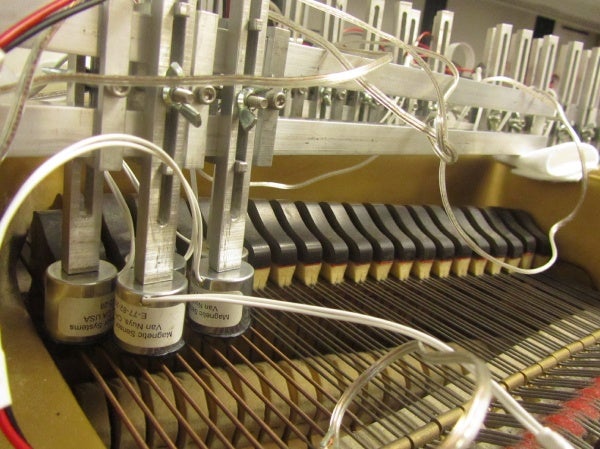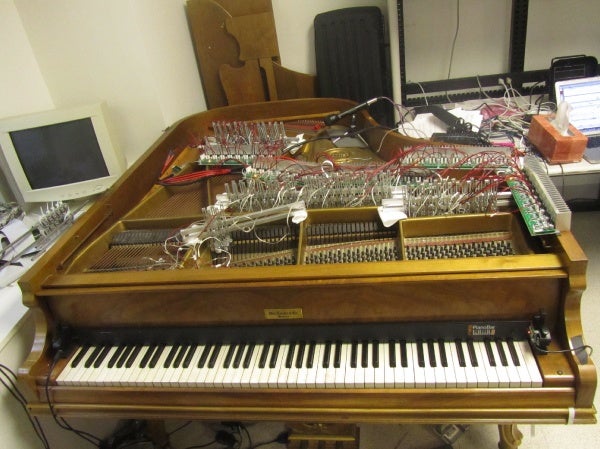With glowing sound, magnetic resonator piano attracts attention
-

The MRP is a standard piano rigged with electromagnets a fraction of an inch above each of its strings. (Peter Crimmins/For NewsWorks)
-

Andrew McPherson, electrical engineer and musician/composer created the magnetic resonator piano. (Peter Crimmins/For NewsWorks)
-

The electromagnet rigging is portable can be removed from the old, battered piano in Drexel's music and entertainment technology lab and reinstalled in a concert grand in a few hours. (Peter Crimmins/For NewsWorks)
-

The electro-acoustic hybrid is not designed to replace the percussive piano sound, but explore what happens after the hammer hits. (Peter Crimmins/For NewsWorks)
-

Each magnet is triggered by a keystroke, and vibrates the string through resonance instead of a hammer. (Peter Crimmins/For NewsWorks)
-

The electromagnet rigging is portable can be removed from the old, battered piano in Drexel's music and entertainment technology lab and reinstalled in a concert grand in a few hours. (Peter Crimmins/For NewsWorks)
This weekend, two piano concerts will showcase the unique qualities of the magnetic resonator piano.
Developed at Drexel University’s music and entertainment technology lab, the MRP is a standard piano rigged with electromagnets a fraction of an inch above each of its strings. Each magnet is triggered by a keystroke, and vibrates the string through resonance instead of a hammer.
“The hammers and magnetic sounds can be added together to make a note that starts with a normal piano attack and is followed by electromagnetic sustain,” said Andrew McPherson, the engineering Ph.D. who created it.
He can strike a key and hold its sustain infinitely, or press a key halfway down to create a softly swelling tone. Unlike those created by a percussive knock of a hammer, notes on the magnetic resonator piano can be manipulated after the attack, similar to a violin vibrato.
“The piano strings want to vibrate at whatever they are tuned to, but with the magnets I can convince them to sound at a slightly different frequency,” said McPherson. “If I hold down a key and lightly touch the one next to it, you get this effect where the note slides in a very vocal manner.”
It sounds a lot like a synthesizer, but the vibrating strings in the piano’s sound chamber cause neighboring strings to quietly vibrate as well, creating a subtle harmonic effect almost impossible to recreate electronically.
The electromagnet rigging is portable. It can be removed from the old, battered piano in Drexel’s music and entertainment technology lab and reinstalled in a concert grand in a few hours, with no damage to either instrument.
The electro-acoustic hybrid is not designed to replace the percussive piano sound, but explore what happens after the hammer hits.
“To be able to induce the string to vibration so that we can hear the after-sound we’re used to after the hammer is struck–the glow that results–and explore that as an independent musical entity,” said McPherson.
Six composers from Philadelphia and Princeton, N.J., were invited to create a new work for the Magnetic Resonant Piano: David Carpenter, William Derganc, Daniel Fox, Daniel Shapiro, Jeff Snyder and Tony Solitro.
Their pieces will premiere Saturday at 7:30 p.m. at Drexel’s Bossone Research Center, and again on Sunday at 3 p.m. at Temple University’s Rock Hall.
WHYY is your source for fact-based, in-depth journalism and information. As a nonprofit organization, we rely on financial support from readers like you. Please give today.





